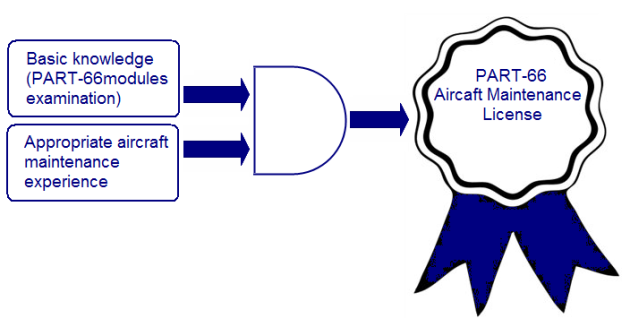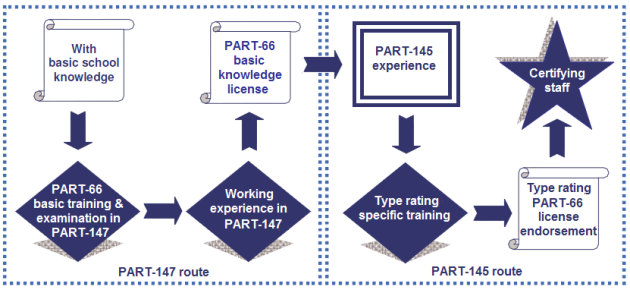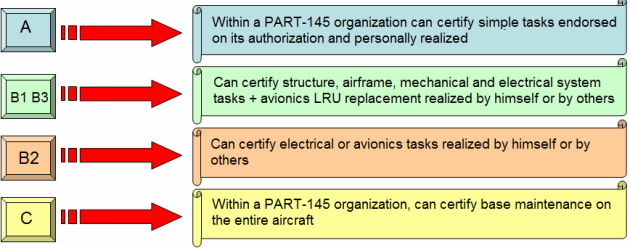DETAILED UNDERSTANDING OF PART-66
1. GENERAL:
The Aircraft Maintenance License (AML) is issued by the Authority designed by the Member States (66.1). EASA (European Aviation Safety Agency) is this authority. The entry in force of the Part-66 requirements could not exceeded the 28th September 2005 for aircraft with a maximum take-off mass above 5 700 kg and the 28th September 2006 for aircraft with a take-off mass of 5 700 kg or below (EC N° 1321/2014).
The Aircraft Maintenance License (AML) is one of the prerequisites needed to become eligible as maintenance certifying staff.
Note:
Whatever the category of license, an applicant to an Aircraft Maintenance License (AML) shall be at least 18 years of age (66.A.15 Eligibility).
An aircraft maintenance license becomes invalid five years after its last issue or amendment (66.A.40 Continued validity of the aircraft maintenance license).
There are five categories of license:
Category A,
Category B1,
Category B2,
Category B3,
Category C.
Categories A et B1 are subdivided into subcategories relative to combinations of aeroplanes, helicopters, turbine and piston engines. The sub-categories are:
A1 and B1.1: Aeroplanes turbine,
A2 and B1.2: Aeroplanes piston,
A3 and B1.3: Helicopters turbine,
A4 and B1.4: Helicopters piston.
Hereunder are represented the different sub-categories.
2. LICENSE ISSUANCE:
An applicant to an Aircraft Maintenance License must demonstrate that he satisfied basic knowledge requirements (66.A.25) and appropriated maintenance experience (66.A.30).
3. BASIC KNOWLEDGE REQUIREMENTS:
To demonstrate he satisfied to the basic knowledge requirements an applicant must succeed the examination of the Part-66 modules relevant to the sub-category of license wanted.
The Part-66 Appendix 1 lists the modules to be passed.
Hereunder the table is reproduced:

4. BASIC EXAMINATION STANDARD:
The basic knowledge examinations shall be conducted by a training organization appropriately approved under Part-147 or by the competent authority.
Full or partial credit against the basic knowledge requirements and associated examination shall be given for any other technical qualification considered by the competent authority to be equivalent to the knowledge standard of this Part.
The basic examination standard is described in Appendix 2 of the Part-66.
→ Typical examination room:
All basic examinations must be carried out using the multi-choice question format and essay questions as specified below:
Each multi-choice question must have three alternative answers of which only one must be the correct answer and the candidate must be allowed a time per module which is based upon a nominal average of 75 seconds per question.
Each essay question requires the preparation of a written answer and the candidate must be allowed 20 minutes to answer each such question.
Suitable essay questions must be drafted and evaluated using the knowledge syllabus in Part-66 Appendix I Modules 7, 9 and 10.
Each question will have a model answer drafted for it, which will also include any known alternative answers that may be relevant for other subdivisions.
The model answer will also be broken down into a list of the important points known as Key Points.
The pass mark for each Part-66 module and sub-module multi-choice part of the examination is 75 %.
The pass mark for each essay question is 75 % in that the candidates answer must contain 75 % of the required key points addressed by the question and no significant error related to any required key point.
If either the multi-choice part only or the essay part only is failed, then it is only necessary to retake the multichoice or essay part, as appropriate.
Penalty marking systems must not be used to determine whether a candidate has passed.
All Part-66 modules that make up a complete Part-66 aircraft maintenance license category or subcategory must be passed within a 5 year time period of passing the first module except in the case specified in paragraph 1.12.
A failed module may not be retaken for at least 90 days following the date of the failed module examination, except in the case of a Part-147 approved maintenance training organization which conducts a course of retraining tailored to the failed subjects in the particular module when the failed module may be retaken after 30 days.
The 5 year time period specified in paragraph 1.11 does not apply to those modules which are common to more than one Part-66 aircraft maintenance license category or subcategory and which were previously passed as part of another such category or subcategory examination.
→ Typical library:
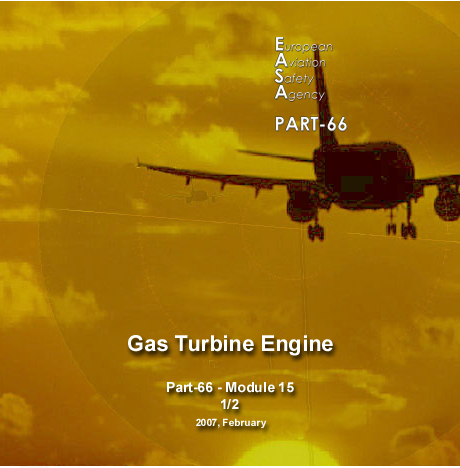
5. AIRCRAFT MAINTENANCE EXPERIENCE:
5.1. ‘Self-starter' route:
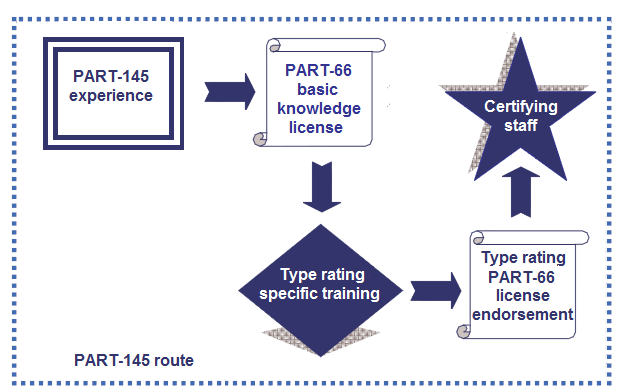
An applicant to an aircraft maintenance license must demonstrate an experience appropriated to the category. That means a minimum of one year of recent experience should be gain on aircraft of the category/.subcategory for which the initial aircraft maintenance license is sought (66.A.30 Experience requirements).
To be considered as recent experience; at least 50% of the required 12 month experience should be gained within the 12 month period prior to the date of application for the Part-66 aircraft maintenance license.
The remainder of the experience should have been gained within the 7 year period prior to application (AMC 66.A.30 (d)).
The duration of required experience depends of the type of training the applicant has attended.
5.1. Ab initio route:
a) For category A and subcategories B1.2, B1.4 and B3:
three years of practical maintenance experience on operating aircraft, if the applicant has no previous relevant technical training; or
two years of practical maintenance experience on operating aircraft and completion of training considered relevant by the competent authority as a skilled worker, in a technical trade; or
one year of practical maintenance experience on operating aircraft and completion of a Part-147 approved basic training course.

b) For category B2 and subcategories B1.1 and B1.3:
five years of practical maintenance experience on operating aircraft if the applicant has no previous relevant technical training; or
three years of practical maintenance experience on operating aircraft and completion of training considered relevant by the competent authority as a skilled worker, in a technical trade; or
two years of practical maintenance experience on operating aircraft and completion of a Part -147 approved basic training course.
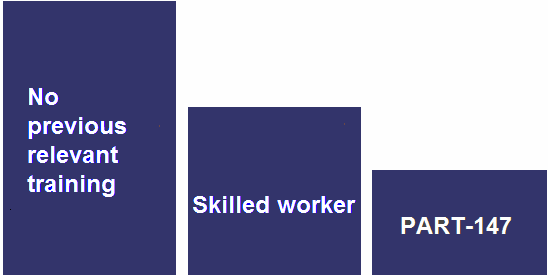
c) For category C with respect to large aircraft:
three years of experience exercising category B1.1, B1.3 or B2 privileges on large aircraft or as Part-145 B1.1, B1.3 or B2 support staff, or, a combination of both; or
five years of experience exercising category B1.2 or B1.4 privileges on large aircraft or as Part-145 B1.2 or B1.4 support staff, or a combination of both; or
d) For category C with respect to non large aircraft:
three years of experience exercising category B1 or B.2 privileges on non large aircraft or as Part-145 B1 or B.2 support staff, or a combination of both; or
e) For category C obtained through the academic route:
three years of experience working in a civil aircraft maintenance environment on a representative selection of tasks directly associated with aircraft maintenance including six months of observation of base maintenance tasks.
6. CONTINUED VALIDITY OF THE AIRCRAFT MAINTENANCE LICENSE:
The aircraft maintenance license becomes invalid five years after its last issue or amendment, unless the holder submits his/her aircraft maintenance license to the competent authority that issued it, in order to verify that the information contained in the license is the same as that contained in the competent authority records, pursuant to 66. B.120.
Any certification privileges based upon a aircraft maintenance license becomes invalid as soon as the aircraft maintenance license is invalid.
The aircraft maintenance license is only valid when issued and/or amended by the competent authority and when the holder has signed the document.
7. TYPE/TASK TRAINING AND RATINGS:
Whatever the category of license delivered by the competent authority, the holder of an aircraft maintenance license may only exercise privileges on a specific aircraft type following the satisfactory completion of the relevant aircraft type/task training (66.A.45 Type/task training and ratings).
This training must be carried out within a Part-147 maintenance training organization.
For A and B categories, a practical training must also be performed. This practical element of the training may be carried out within a Part-147 maintenance training organization or a Part-145 maintenance organization.
8. TYPE TRAINING AND EXAMINATION STANDARD:
The type training and examination standard is described in Appendix 3 of the Part-66.
There are 3 levels of training:
Level 1: General Familiarization,
Level 2: Ramp & Transit,
Level 3: Line & base maintenance training.
A syllabus lists the subjects to be covered and the level of training by category.
Where aircraft type training is required, the examination must be written and must comply with the following:
Format of the examination is of the multiple-choice type. Each multiple-choice question must have three alternative answers of which only one must be the correct answer. The time for answering is based upon a nominal average of 120 seconds per level 3 question and 75 seconds per level 1 or 2 question.
The examination must be of the closed book type. No reference material is permitted. An exception will be made for the case of examining a B1 or B2 candidate's ability to interpret technical documents.
The number of questions must be at least one question per hour of instruction subject to a minimum of two questions per Syllabus subject. The competent authority of the Member State will assess number and level of questions on a sampling basis when approving the course.
The examination pass mark is 75 %.
Penalty marking is not to be used to determine whether a candidate has passed.
End of module phase examinations cannot be used as part of the final examination unless they contain the correct number and level of questions required.
Note:
For aircraft listed by the agency as non large and non complex aircraft, the type training is not required, only the examination (66.A.45 (g)).
9. NON LARGE NON COMPLEX AIRCRAFT GROUPS:
For aircraft other than large aircraft, the holder of a category B1, B2 or B3 aircraft maintenance license may also exercise certification privileges, when the aircraft maintenance license is endorsed with the appropriate group ratings, or manufacturer group ratings, unless the Agency has determined that the complexity of the aircraft in question requires a type rating.
Manufacturer group ratings may be granted after complying with the type rating requirements of two aircraft types' representative of the group from the same manufacturer.
Full group ratings may be granted after complying with the type rating requirements of three aircraft types representative of the group from different manufacturers.
However, no full group rating may be granted to B1 multiple turbine engine aeroplanes, where only manufacturer group rating applies.
The groups shall consist of the following:
a) For category B1, B3 or C:
helicopter piston engine,
helicopter turbine engine,
aeroplane single piston engine — metal structure,
aeroplane multiple piston engines — metal structure,
aeroplane single piston engine — wooden structure,
aeroplane multiple piston engines — wooden structure,
aeroplane single piston engine — composite structure,
aeroplane multiple piston engines — composite structure,
aeroplane turbine — single engine,
aeroplane turbine — multiple engine.
b) For category B2 or C:
aeroplane,
helicopter.
10. PRIVILEGES:
The holder of an aircraft maintenance license could issue certificate of release (66.A.20 Privileges) as hereunder defined:
A category A aircraft maintenance license permits the holder to issue certificates of release to service following minor scheduled line maintenance and simple defect rectification within the limits of tasks specifically endorsed on the authorisation. The certification privileges shall be restricted to work that the license holder has personally performed in a Part-145 organisation.
A category B1 and B3 aircraft maintenance license shall permit the holder to issue certificates of release to service following maintenance, including aircraft structure, powerplant and mechanical and electrical systems. Replacement of avionic line replaceable units, requiring simple tests to prove their serviceability, shall also be included in the privileges. Category B1 shall automatically include the appropriate A subcategory.
A category B2 aircraft maintenance license shall permit the holder to issue certificates of release to service following maintenance on avionic and electrical systems.
A category C aircraft maintenance license shall permit the holder to issue certificates of release to service following base maintenance on aircraft. The privileges apply to the aircraft in its entirety in a Part-145 organization.
The holder of an Aircraft Maintenance License (AML) may not exercise certification privileges unless:
In compliance with the applicable requirements of Part-M and/or Part-145.
In the preceding two-year period he/she has, either had six months of maintenance experience in accordance with the privileges granted by the aircraft maintenance license or, met the provision for the issue of the appropriate privileges.
He/she is able to read, write and communicate to an understandable level in the language(s) in which the technical documentation and procedures necessary to support the issue of the certificate of release to service are written.
11. LICENSE AMENDMENTS:
An aircraft maintenance license holder can extend it to a new category.
For that the applicant must comply with the same requirements than for a first issuance but the appropriate aircraft maintenance experience will be as listed in the table hereunder:

